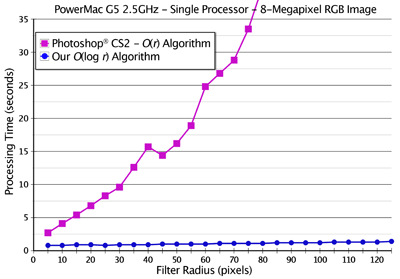|
Abstract
Median filtering is a cornerstone of modern image processing, and is used extensively in smoothing and de-noising applications. The fastest commercial implementations (e.g. in Adobe® Photoshop® CS2) exhibit O(r) runtime in the radius of the filter, which limits their usefulness in realtime or resolution-independent contexts. We introduce a CPU-based, vectorizable O(log r) algorithm for median filtering, to our knowledge the most efficient yet developed. Our algorithm extends to images of any bit-depth, and can also be adapted to perform bilateral filtering. On 8-bit data [shown at right], our median filter outperforms Photoshop’s implementation by up to a factor of fifty.
|
|

|
|




